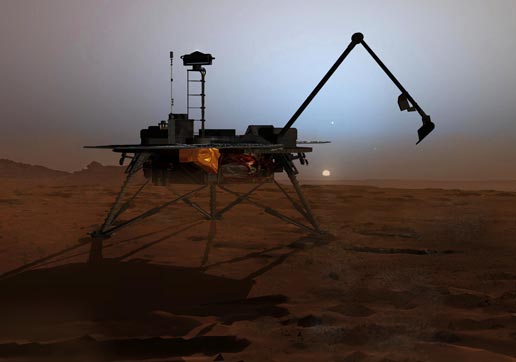All trekkies gather please. A NASA spacecraft today sent pictures showing itself in good condition after making the first successful landing in a polar region of Mars.
The images from NASA's Mars Phoenix Lander also provided a glimpse of the flat valley floor expected to have water-rich permafrost within reach of the lander's robotic arm. The landing ends a 422-million-mile journey from Earth and begins a three-month mission that will use instruments to taste and sniff the northern polar site's soil and ice.
"We see the lack of rocks that we expected, we see the polygons that we saw from space, we don't see ice on the surface, but we think we will see it beneath the surface. It looks great to me," said Peter Smith of the University of Arizona, Tucson, principal investigator for the Phoenix mission.
Radio signals received at 4:53:44 p.m. Pacific Time (7:53:44 p.m. Eastern Time) confirmed that the Phoenix Mars Lander had survived its difficult final descent and touchdown 15 minutes earlier. In the intervening time, those signals crossed the distance from Mars to Earth at the speed of light. The confirmation ignited cheers by mission team members at NASA's Jet Propulsion Laboratory, Pasadena, Calif.; Lockheed Martin Space Systems, Denver; and the University of Arizona.
As planned, Phoenix stopped transmitting one minute after landing and focused its limited battery power on opening its solar arrays, and other critical activities. About two hours after touchdown, it sent more good news. The first pictures confirmed that the solar arrays needed for the mission's energy supply had unfolded properly, and masts for the stereo camera and weather station had swung into vertical position.
Read - Phoenix mission page
Read - NASA live video feed
Read - NASA Mission Control liveblog

